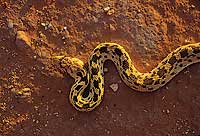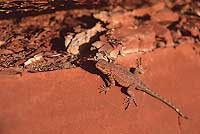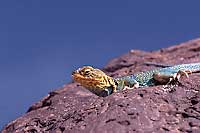Summer represents reptile time in the Canyon Country. Snakes and lizards, cold-bloodied creatures known as ectotherms, rely upon external heat to regulate their body temperatures. Alternating between sun and shade, lazy lizards and patient snakes carry out their daily activities before the cold of winter drives them into hibernation.
Throughout my time as a Park Ranger at Arches National Park, many visitors shared their worries about rattlesnakes. Most of my encounters of the overly-feared midget faded rattlesnake occurred in the Devils Garden Campground or as road kill on the park’s paved road. Rarely did I find them alive along the trails. I used to tell visitors they would be lucky to see one; many of them did not embrace my snake endorsement.
During my ten year tenure as a seasonal ranger, I rarely dealt with a snakebite victim (most go unreported). There was one German woman who was bitten on the buttock but didn’t have any swelling or pain associated with the bite. Adult rattlers can control their envenomation – so not all bites include venom. In Utah, there have only been a handful of deaths associated with rattlesnake bites since the early 1900s. You have a much greater risk of being squashed by a vending machine than you do of dying from a poisonous snakebite.
Rattlers are masters of procrypsis – meaning a patterning or cryptic coloration - to avoid detection. The snakes lay in wait for prey, aware of potential conflicts from intruders by feeling vibrations, sensing body heat with pits near their mouths and testing the air for scent with their tongues.
To warn wayward walkers, the snakes rapidly contract small “shaker” muscles near the tail tip which causes the hollow segments or buttons, i.e. the rattle, to vibrate. The hollow nature of the segments amplifies the sound. The muscles fire around 50 times per second and the snake can sustain this rattle for several hours; anyone getting that much warning deserves a dose of venom.
 Besides the buzzworms, there are several other snakes one might encounter such as gopher snakes, garter snakes or whipsnakes. Gopher snakes cash in on the rattlesnake’s reputation by imitating their venomous relatives. Coiling up and vibrating their tail when disturbed, this mimicry may deter some predators, but not all. I have seen these snakes clutched in the talons of high flying hawks before the birds open their bomb bays and let the snakes smash into the rocks below. Broken prey is a lot easier to haul than writhing prey.
Besides the buzzworms, there are several other snakes one might encounter such as gopher snakes, garter snakes or whipsnakes. Gopher snakes cash in on the rattlesnake’s reputation by imitating their venomous relatives. Coiling up and vibrating their tail when disturbed, this mimicry may deter some predators, but not all. I have seen these snakes clutched in the talons of high flying hawks before the birds open their bomb bays and let the snakes smash into the rocks below. Broken prey is a lot easier to haul than writhing prey.
The other half of the reptile card is filled with lizards. From small side-blotched to larger collared lizards, there is a diversity of these creatures that occurs in the region.

 Side-blotched and tree lizards are two of the smaller lizards that scoot across the sandstone. Their small size lets them exploit being active at cooler temperatures than some of the larger lizards that may prey upon them. It takes less warmth to heat up their small mass than it takes the larger species to warm up.
Side-blotched and tree lizards are two of the smaller lizards that scoot across the sandstone. Their small size lets them exploit being active at cooler temperatures than some of the larger lizards that may prey upon them. It takes less warmth to heat up their small mass than it takes the larger species to warm up.
Whiptails, known for their long whiplike tail, are long, slender lizards that hunt for insects and ants. Their active style of hunting for prey differs from the more “watch-and-wait” approach of the larger leopard and collared lizards.
So during the heat of summer keep an eye out for these reptilian desert dwellers and incorporate a “hands off” policy that will keep lizard tails intact and preclude a visit to the emergency room.

 Besides the buzzworms, there are several other snakes one might encounter such as gopher snakes, garter snakes or whipsnakes. Gopher snakes cash in on the rattlesnake’s reputation by imitating their venomous relatives. Coiling up and vibrating their tail when disturbed, this mimicry may deter some predators, but not all. I have seen these snakes clutched in the talons of high flying hawks before the birds open their bomb bays and let the snakes smash into the rocks below. Broken prey is a lot easier to haul than writhing prey.
Besides the buzzworms, there are several other snakes one might encounter such as gopher snakes, garter snakes or whipsnakes. Gopher snakes cash in on the rattlesnake’s reputation by imitating their venomous relatives. Coiling up and vibrating their tail when disturbed, this mimicry may deter some predators, but not all. I have seen these snakes clutched in the talons of high flying hawks before the birds open their bomb bays and let the snakes smash into the rocks below. Broken prey is a lot easier to haul than writhing prey. 
 Side-blotched and tree lizards are two of the smaller lizards that scoot across the sandstone. Their small size lets them exploit being active at cooler temperatures than some of the larger lizards that may prey upon them. It takes less warmth to heat up their small mass than it takes the larger species to warm up.
Side-blotched and tree lizards are two of the smaller lizards that scoot across the sandstone. Their small size lets them exploit being active at cooler temperatures than some of the larger lizards that may prey upon them. It takes less warmth to heat up their small mass than it takes the larger species to warm up.